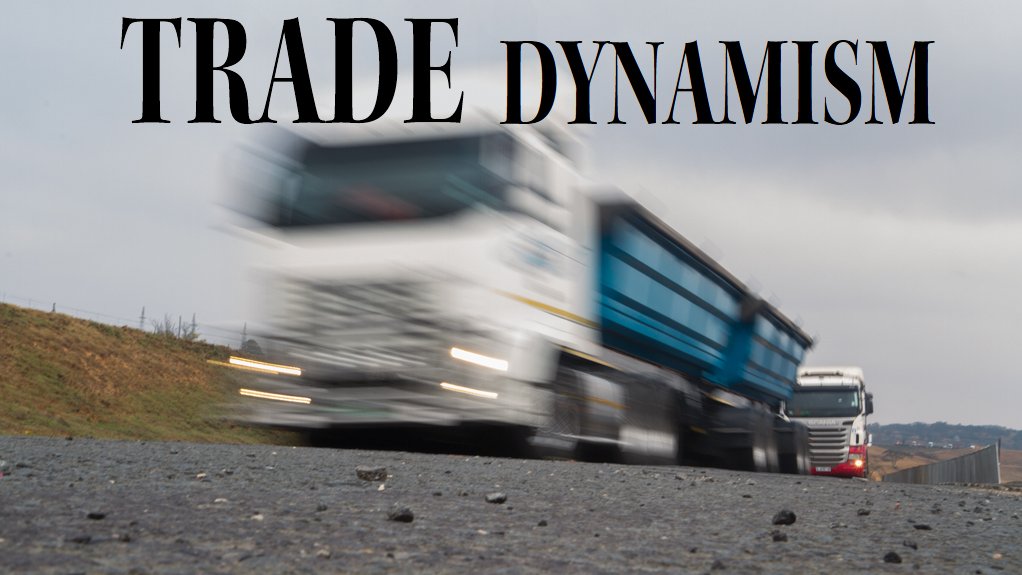African trade corridors have potential to spur development, drive transformation
The role of business in the successful and sustainable operation of trade corridors is being recognised by researchers and national governments, says a range of African trade and investment professionals.
Trade corridors spur development and drive the transformation of economic sectors and even entire markets, but can be successful only if they meet business demand for reliability, transparency of lead times and efficiency, specifically with regard to turnaround times and costs.
This is especially significant for landlocked countries to get their produce and imports to and from ports efficiently. Corridors can help to overcome the World Bank ‘De-fragmenting Africa’ report finding that Africa has integrated with the rest of the world faster than it has as a continent.
Difficult trading conditions and unpredictable delays can reduce access to infrastructure development for countries, as barriers to trade and supply chain inefficiencies reduce competitiveness and increase development costs. Therefore, integrated transport corridors between countries can lower costs of business significantly, says South African Transport Forum custodian Harry van Huyssteen.
The maturity of a trade corridor is based on its infrastructure development and physical integration, as well as the supporting systems and the continuous engagement among stakeholders to address issues. These can include a lack of efficiency, national security or smuggling risks, he explains.
Business Dialogue
African trade and investment researcher and The Next Africa coauthor Aubrey Hruby highlights that the Northern Corridor Integration project has reduced the transit time from the Kenyan port of Mombasa to the landlocked Rwandan capital of Kigali from 22 days to 5 days, which was achieved by reducing inefficiencies in the process without making any new investments along the corridor.
“This is the result of businesses bringing pressure to bear to reduce barriers. One of the best things African governments and business can do right now is to attack the inefficiencies at home,” emphasises Hruby.
“The new African business classes are bringing pressure to bear that is reducing travel times, such as from Mombasa to Kigali,” she highlights.
East-west trade corridor management company Maputo Corridor Company CEO Barbara Mommen reinforces this view by noting the crucial role of dialogue between customs officials and businesses using the Maputo corridor in improving the movement of goods and trade. An effective system to exchange information is necessary before complex issues such as bilateral and customs agreement challenges can be addressed.
The information exchange and dialogue platform, used by public and private Maputo corridor stakeholders, has helped to highlight and correct deficiencies and challenges in new systems, such as the freight preclearance systems. The dialogue has also led to the development of other trade facilitation systems, such as the secure locking system, where precleared cargo is securely locked and can be opened only at the port or destination.
“Trade corridors rely primarily on supply chain efficiencies, and every element of the corridor must perform its role, including efficient infrastructure and customs processes, as well as regu- latory and legal requirements.
“For landlocked countries, access to ports is crucial, but competitiveness must not be compromised by border processes. They rely on their neighbours to move cargo, and the impact of a lack of efficient transport corridors is enormous. This is where pressure and suggestions from business to develop corridors are necessary,” she says.
Mommen highlights that, despite a large portion of South Africa’s agricultural produce being grown in the eastern parts of the country – which are only a few hours by road from the Port of Maputo – much of the produce is routed to the Port of Durban or other South African ports for export.
Improving the efficiencies of the Maputo corridor, particularly the Lebombo-Ressano Garcia border post, will attract more trade to the corridor, and can be a boon for agricultural produce exporters and those seeking alternative supply chain options.
“We compete in terms of speed against the other ports, and we have been able to achieve an average of 29 to 40 minutes for border clearance procedures for large trucks. These efficiencies are a direct result of the interaction between businesses and border agencies.”
Mommen notes that Mozambique has introduced an electronic customs and clearance system, which had significant teething problems and reduced the efficiencies it was supposed to improve. However, key obstacles that prevented its effective functioning were identified through stakeholder engagement and cross-border efficiencies improved.
Customs Intelligence
Despite the benefits of improved trade flows, borders and border posts are still generally viewed as expenses by governments, rather than as crucial to facilitating trade and growing markets, she highlights.
A key problem with typical regulatory frameworks for customs and border post management is a focus on operational targets and processes, rather than on intelligence-based risk.
“The reality we face is that targets are damaging the confidence business has in trade corri- dors, as customs and security checks just to meet targets can be excessive and sometimes obstructive,” she states.
Mommen adds that the correct way of addressing the twin challenges of efficiency and legality is to base checks on risk profiles, in conjunction with spot checks.
Van Huyssteen concurs, noting that true efficiencies are gained when border agencies collaborate on, for example, information sharing, such as from weigh bridges on either side of the border, reducing duplication.
While inter-State information sharing is generally not well established, there is growing recognition of the crucial role of information sharing and dialogue with businesses using trade corridors.
South African Revenue Service (Sars) spokesperson Sandile Memela says Sars’ approach, since its Customs Modernisation Programme started in 2009, is one of intelligence-driven risk management to target high-risk, noncompliant traders, leveraging engagement with business to promote voluntary compliance.
To achieve this, information is key, he says. Sars needs to obtain as much information as possible prior to the arrival of goods at ports of entry. This, in turn, requires modern information technology that enables the secure, real-time exchange of information, and subsequent risk profiling and processing of declarations.
“The 2012 phase of the Customs Modernisation Programme saw the enforcement of electronic goods declarations and the limitation of declarations that can be processed manually at four border posts with South Africa’s neighbouring countries, namely Botswana, Namibia and landlocked Lesotho and Swaziland.
The electronic manifests, also introduced in 2012, had an immediate positive impact on the movement of commercial trucks through the border posts. Automated gate arrival and departure processes with electronic release systems and forms that can be scanned using hand-held devices, have replaced gate passes as a control measure for commercial vehicles travelling across the border.
Electronic submissions as a percentage of total declarations have grown from 38% to 99% and Sars processes the electronic manifests of 20 000 to 25 000 trucks a month, he says.
Van Huyssteen acknowledges the modernisation work done by Sars and its impact on the efficiencies of the country’s border posts, as well as its role in stimulating neighbouring countries to introduce similar automated processes, while highlighting remaining shortcomings.
Trade Integration
The next phase of integrating trade in Africa is to invest money and effort in improving regional infrastructure, trade integration and competitiveness. The World Bank has also made a trade and transport corridor management toolkit available as a reference for corridor development and sustainable management, says Mommen.
The agreement and commencement last year of technical work for the 26-country Tripartite Free Trade Area – comprising the Common Market for Eastern and Southern Africa, the East African Community and the Southern African Development Community (SADC) – is encouraging, notes Memela, adding that Sars is committed to regional economic integration, including through the five-country Southern African Customs Union and the 15-country SADC trade blocs.
However, further work can be done to reduce inefficiencies, and the Maputo corridor can handle greater volumes of trade if further changes are made, such as the introduction of a permanent 24/7 border post and better management of officials conducting discretionary spot checking, states Mommen.
“Reducing human intervention and duplication of work, such as inspection and weighing, will reduce risks and stimulate more efficient trade flows through corridors,” explains Van Huyssteen.
“The corridors and the business communities surrounding them play a key role in developing the environment where these automated processes effectively address the concerns of all stakeholders, making trade more efficient, safe, reliable and predictable.”
Comments
Press Office
Announcements
What's On
Subscribe to improve your user experience...
Option 1 (equivalent of R125 a month):
Receive a weekly copy of Creamer Media's Engineering News & Mining Weekly magazine
(print copy for those in South Africa and e-magazine for those outside of South Africa)
Receive daily email newsletters
Access to full search results
Access archive of magazine back copies
Access to Projects in Progress
Access to ONE Research Report of your choice in PDF format
Option 2 (equivalent of R375 a month):
All benefits from Option 1
PLUS
Access to Creamer Media's Research Channel Africa for ALL Research Reports, in PDF format, on various industrial and mining sectors
including Electricity; Water; Energy Transition; Hydrogen; Roads, Rail and Ports; Coal; Gold; Platinum; Battery Metals; etc.
Already a subscriber?
Forgotten your password?
Receive weekly copy of Creamer Media's Engineering News & Mining Weekly magazine (print copy for those in South Africa and e-magazine for those outside of South Africa)
➕
Recieve daily email newsletters
➕
Access to full search results
➕
Access archive of magazine back copies
➕
Access to Projects in Progress
➕
Access to ONE Research Report of your choice in PDF format
RESEARCH CHANNEL AFRICA
R4500 (equivalent of R375 a month)
SUBSCRIBEAll benefits from Option 1
➕
Access to Creamer Media's Research Channel Africa for ALL Research Reports on various industrial and mining sectors, in PDF format, including on:
Electricity
➕
Water
➕
Energy Transition
➕
Hydrogen
➕
Roads, Rail and Ports
➕
Coal
➕
Gold
➕
Platinum
➕
Battery Metals
➕
etc.
Receive all benefits from Option 1 or Option 2 delivered to numerous people at your company
➕
Multiple User names and Passwords for simultaneous log-ins
➕
Intranet integration access to all in your organisation





















